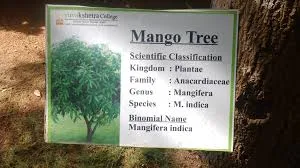Table of Contents
2 :2 :2. Environmental Impact1. Nature of the Mango Tree1 :1. Botanical Characteristics1 :2. Climate1 :3. Lifespan2. Uses and Benefits of the Mango Tree2 :1. Fruit Production2 :1 :1. Nutritional Value2 :1: 2. Culinary Use2 :2. Wood2 :2 :1. Construction
3 :1. Medicinal Properties
3 :1 :2. Healing Uses3 :1 :1. Leaves and Bark
3. Environmental Contributions3 :1. Air Purification3 :2. Shade and Erosion Control4. Conclusion
The mango tree (Mangifera indica) is a tropical evergreen tree widely known for its delicious fruit, but its value extends beyond just the fruit it bears. Let's explore its nature and its numerous uses.
Nature of the Mango Tree:
- Botanical Characteristics: Mango trees are large, growing up to 30 meters (98 feet) tall. They have dense, evergreen foliage with broad leaves that can be up to 40 cm long.
- Climate: The mango tree thrives in tropical and subtropical climates. It requires warm temperatures, plenty of sunlight, and well-drained soil.
- Lifespan: A mango tree can live for over 100 years, producing fruit for decades.
Uses and Benefits of the Mango Tree:
Fruit Production:
- Nutritional Value: Mangoes are rich in vitamins A, C, and E, dietary fiber, and antioxidants. The fruit supports digestion, boosts immunity, and promotes skin health.
- Culinary Use: Mangoes can be consumed raw, made into juices, jams, desserts, or dried snacks. Green mangoes are often used in chutneys, pickles, and savory dishes.
Wood:
- Construction: Mango wood is durable and used in furniture, paneling, and flooring. It is known for its resistance to decay and aesthetic appeal.
- Environmental Impact: Mango trees offer a sustainable source of wood since they can be replanted after their fruit-bearing years are over.
Medicinal Properties:
- Leaves and Bark: The leaves of the mango tree have been traditionally used in herbal medicine for treating ailments like diabetes, diarrhea, and respiratory issues.
- Healing Uses: Mango seed extracts and mango leaves have antioxidant, antimicrobial, and anti-inflammatory properties.
Environmental Contributions:
- Air Purification: Like other trees, mango trees play a vital role in absorbing carbon dioxide and releasing oxygen, improving air quality.
- Shade and Erosion Control: Mango trees provide shade and help prevent soil erosion, especially in rural areas where they are widely planted.
Conclusion:
The mango tree is not only valued for its sweet, juicy fruit but also for its wood, medicinal properties, and environmental benefits. Its adaptability and usefulness make it a significant tree in many parts of the world.
SPONSOR - KEY - WORD
"This Content Sponsored by Genreviews.Online
Genreviews.online is One of the Review Portal Site
Website Link: https://genreviews.online/
Sponsor Content: #genreviews.online, #genreviews, #productreviews, #bestreviews, #reviewportal"











No comments:
Post a Comment
Yes